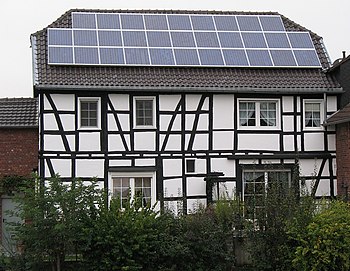Electric power
Electric energy is the form of energy that results from the existence of a potential difference between two points, which allows an electric current to be established between them when they are brought into contact by means of an electrical conductor. Electrical energy can be transformed into many other forms of energy, such as light energy or light, mechanical energy, and thermal energy.
Electric current
Electrical energy manifests itself as an electric current, that is, as the movement of negative electric charges, or electrons, through a metallic conductor cable as a consequence of the potential difference that a generator is applying at its ends.
Every time a switch is activated, an electrical circuit is closed and the movement of electrons through the conducting wire is generated. The charges that move are part of the atoms of the substance of the cable, which is usually metallic, since metals —by having more free electrons than other substances— are the best conductors of electricity. Most of the electrical energy that is consumed in daily life comes from the electrical network through sockets called plugs, through which the energy supplied by the electrical companies arrives to the different electrical devices —washing machine, radio, television, etc.— that you want to use, through the corresponding transformations; For example, when electrical energy reaches a polishing machine, it is converted into mechanical, caloric, and in some cases light energy, thanks to the electric motor and the different mechanical parts of the devices.
Sources of electrical energy
Electrical energy exists freely in nature in a usable way. The most relevant and common example of this manifestation is electrical storms. Neither does electricity have a direct biological utility for humans, except in very unique applications, such as the use of currents in medicine (electroconvulsive therapy), instead it is usually unpleasant and even dangerous, depending on the circumstances. However, it is one of the most used, once applied to processes and devices of the most diverse nature, mainly due to its cleanliness and the ease with which it is generated, transported, and converted into other forms of energy. In order to counteract all these virtues, it is necessary to review the difficulty presented by its direct storage in devices called accumulators.
The generation of electrical energy is carried out using very different techniques. Those that supply the largest quantities and powers of electricity take advantage of a rotary movement to generate direct current in a dynamo or alternating current in an alternator. The rotary movement results in turn from a direct mechanical energy source, such as a current from a waterfall or that produced by the wind, or from a thermodynamic cycle. In the latter case, a fluid is heated, which is made to travel through a circuit in which it moves an engine or a turbine. The heat of this process is obtained through the burning of fossil fuels, nuclear reactions among other processes.
The generation of electrical energy is a basic human activity, since it is directly related to the current requirements of man. All forms of use of energy sources, both the usual ones and the so-called alternative or non-conventional ones, attack the environment to a greater or lesser extent, although electrical energy is one of those that cause the least impact.
Generation, distribution and commercialization
Generation can be related to distribution, except in the case of self-consumption.
Electric power generation
Currently, electrical energy can be obtained from different means, which are mainly divided into:
- Renewable:
- Solar thermoelectric plants
- Photovoltaic solar plants
- Wind power stations
- Hydroelectric power stations
- Geothermal power plants
- Non-renewable:
- Nuclear power stations
- fossil fuels:
- Combined cycle centers (natural gas burners)
- Turbo-gas hubs
Common failures in the electrical power supply
Power outage
A power outage is defined as a zero voltage condition on the power supply that lasts for more than two cycles (40 ms). It can be caused by a switch being turned on, a problem in the user's installation, a failure in the electrical distribution or a failure in the commercial network. This condition can lead to partial or complete data loss, file corruption, and hardware damage.
During the history of humanity there have been several electrical blackouts in the world, due to various causes, whether they are human failure, due to damage to electronic equipment, overload, short circuit or inclement weather, but there have also been made some intentional blackouts, in 2007 and 2009, in protest of climate change. One of the most remembered blackouts in history was the one in New York, on November 9, 1965, in addition to having paralyzed the metropolis for 24 hours, it is also well remembered because nine months after the blackout, there were a number of births higher than normal.[citation needed] The most recent occurred in Chile, which affected almost the entire country, shortly after the earthquakes that struck that country.[citation required]
Electrical noise
Electrical line noise is defined as Radio Frequency Interference (RFI) and Electromagnetic Interference (EMI) and causes undesirable effects in the electronic circuitry of computer systems.
Sources of the problem include electric motors, relays, motor control devices, broadcast transmissions, microwave radiation, and distant electrical storms.
RFI, EMI and other frequency problems can cause errors or loss of stored data, communications interference, keyboard and system hangups.
High voltage spikes occur when there are sudden increases in voltage within a few microseconds. These spikes are usually the result of a nearby lightning strike, but there may be other causes as well. The effects on vulnerable electronic systems can include anything from data loss to deterioration of power supplies and equipment circuit boards. Equipment damaged by this cause are frequent.
Tensions
- An overvoltage occurs when the voltage exceeds 110 % of the nominal value. The most common cause is the disconnection or the shutdown of large loads on the network. Under this condition, computer equipment may experience memory loss, data errors, computer shutdown and premature aging of electronic components.
- A voltage drop includes voltage values below 80% or 85 % of normal voltage over a short period. Possible causes are: ignition of large-scale equipment or high-power electric motors and switching of main power switches (internal or usine). A drop of tension may have effects similar to those of an overvoltage.
- A voltage transient takes place when there are voltage peaks up to 150 000 volts with a duration between 10 and 100 μs. They are usually caused by electric arches and static discharges. Maneuvers of usins to correct flaws in the network that generate these transients can occur several times a day. The transient effects of this type may include loss of data in memory, error in data, loss of data and extreme requests in electronic components.
- One frequency variation involves a change in the nominal frequency of the feeding of the equipment, usually stable at 50 or 60 Hz depending on this of the geographical location. This case may be caused by the erratic functioning of generators or by instability in power supply sources. For sensitive electronic equipment, the result can be data corruption, hard drive shutdown, keyboard blocking and program failures.
If these failures are repeated, they can cause very high monetary losses in companies and industries. An element that can help to overcome this type of electrical failure and offer a safe electrical supply is with the installation of an uninterruptible power supply system.
Energy consumption and energy efficiency
Electrical devices, when they are working, generate electrical energy consumption depending on the power they have and the time they are in operation. In Spain, electricity consumption is accounted for by means of a sealed device that is installed at the entrances to the home, called a meter, and that is checked every two months by an employee of the electricity supply company, noting the consumption made in that period. The kilowatt hour (kWh) is the unit of energy in which household or industrial electricity consumption is normally billed. It is equivalent to the energy consumed by an electrical device whose power was one kilowatt (kW) and was running for one hour.
| Concept | Calculation | Value |
|---|---|---|
| Power contracted | 5.5 kW x 2 monthsx 1,642355 €/(kW • month) | 18,07 € |
| Cost consumption | 966 kWh x 0,091437 €/kWh | 88.33 € |
| Electricity tax | 106,40 € x 1,05113 x 4.864% | 5,44 € |
| Rental of accountant | 0,60 €/month x 2 months | 1,20 € |
| Value added tax (VAT) | 16 % x previous sum | 18,09 € |
| Total invoice | 131,13 € | |
Given the high cost of electrical energy and the difficulties that exist to cover the global demand for electricity and the harmful effect on the environment caused by the massive production of electricity, the need to apply the maximum possible energy efficiency in all uses made of electrical energy.
The energy efficiency is the relationship between the amount of energy consumed by the products and the final benefits obtained. It can be achieved to increase it through the implementation of various measures and investments at the technological level, management and cultural habits in the community.
Health and electricity
The electrical risk is the name given to the risk caused by electrical energy. This type of risk includes the following:
- Electric shock by contact with voltage elements (direct electrical contact), or with masses accidentally placed in voltage (indirect electrical contact).
- Electric shock burns, or electric arc.
- Falls or blows as a consequence of shock or electric arc.
- Fire or explosions originated by electricity.
Electrical current can cause immediate effects such as burns, cramps, or fibrillation, and delayed effects such as mental disorders. It can also cause indirect effects such as falls, blows or cuts.
The main factors influencing electrical risk are:
- Electric current intensity.
- The duration of electrical contact.
- The impedance of electrical contact, which depends mainly on the humidity, the contact surface and the tension and frequency of the applied voltage.
- The tension applied. In itself it is not dangerous but, if the resistance is low, it causes the passage of a high intensity and therefore very dangerous. The relationship between intensity and tension is not linear because of the fact that the impedance of the human body varies with the contact tension.
- Frequency of the electric current. Most often, the impedance of the body is lower. This effect decreases by increasing the electrical voltage.
- Current pathway through the body. By crossing vital organs, such as the heart, very serious injuries may occur.
Accidents caused by electricity can be minor, serious and even fatal. In case of death of the injured party, it is called electrocution.
In the world of work, employers must adopt the necessary measures so that the use or presence of electrical energy in the workplace does not result in risks to the health and safety of workers or, if this is not possible, so that such risks are minimized.
Contenido relacionado
Weight
Electron cloud
Centimeter




